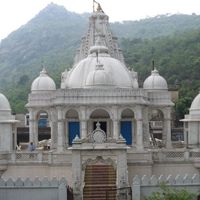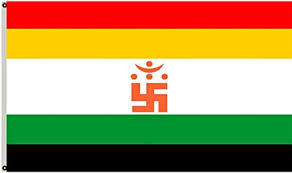Shri Samet Shikar Tirth

The history of this tirth is very ancient. This paramount tirth was known by the names - Samet Shail, Sametachal, Samet Giri, Samet Shikhari, Samadhi Giri, Samidi Giri etc. At present, it is known as Samet Shikhar or Parshvanath Pahad. Twenty Tirthankaras of the preset group of twenty- four tirthnkaras and a number of Tirthankaras of the past groups of twenty- four Tirthankaras, attained salvation on this holy land. There is a reference that in the second century Acharya Padliptasuriji came on a pilgrimage to this place by akashgamini vidya. Palganj was the original foot of Samet Shikhar and the present-day Madhuvan is at a distance of 20 kilometers from Palganj. Madhuvan is the present-day foot of the hill. Since it was the land of penance and of nirvana of many Tirthankaras and Sadhus, every particle of this land is great, holy, and adorable. A touch of this land purifies the human birth. A pilgrimage to this sacred place removes trouble adds to religious merits (punya) and destroys bad karma of devotees. This tirth was renovated many times and its last renovation was accomplished sometime between the years 1803 and 1841 of the Vikram era. Sheth Khushaldas often came on a pilgrimage to this place and the idols had become very old. It was difficult to identify the places of nirvana of different Tirthankaras. Therefore, according to instructions of Devavijayagani, he practiced the penance of a three-day fast (attham) and muttered prayers (jaap) to Padmavatidevi. He saw a dream. Accordingly, he saw on the hill an auspicious figure of Swastika with particular numbers. The places of nirvana of tirthnkaras were fixed according to the numbers. With blessings of the goddess, Khushaldas built small temples of foot idols of these twenty Tirthankaras, a large temple named jalmandir, the Kothi dharmashala at the Madhuvan foot of the hill, the temple of Bhomiyadev and the seven temples of shamaliyaji Parshvanath and others. He thus performed immortal acts of religious worship. When His Holiness Acharyadev Sagaranandasurishvarji came on a pilgrimage to this place in the year 1980-81 of the Vikram era, the twenty-second renovation of this great sacred place was begun according to his wish in the year 23012 of the Vikram era. Under the auspices of Maneksagarsurishvarji Maharaja, disciple of His Holiness Sagarandasurishvarji, the jalmandir and the twenty-nine Devkulikas were installed. AS the name suggests, Madhuvan, the foot of the hill is really a beautiful forest. At this foot of the hill surrounded by hills, trees, gardens and natural beauty, there is temple of Bhomiyadev. There is a splendid hill-shaped idol. It is very impressive. By merely seeing him, one makes one’s journey comfortable. This actually wakeful idol protects the denoted pilgrims who pray to it and removes their obstacles. There are also a dharmashal, a bhojanashal, a beautiful garden and a group of eleven temples. They remind one of the chief tunk of Palitana. The ascent on the hill begins from a little distance beyond the Bhomiyadev temple. The ascent of six miles, six miles of round journey for seeing the tunk and descent of six miles make a journey of 18 miles. If the journey is begun at about 5 o’clock in the morning, it is completed at about 4 O’clock in the evening. For a pilgrim, it is desirable to keep a torch and a stick with him. For using on the journey, food is given to the pilgrims, when they return. It is convenient to ascent by the way of the Jalmandir and descends by the way of the tunk of Bhagawan Parshvanath. When the pilgrims climb half the distance, the tunks of nirvana places of Bhagawan are seen. (1) The first tunk of Gautam Swami: The first tunk is of Gautam Swami, the treasure of many achievements. In the temples, there are foot-idols of twenty- four Tirthankaras and Gautam Swami attained salvation on the fifth hill in the city of Rajagrahi. But the tunk is made for pilgrims to see. All the tunks on Samet Shikhargiri are seen from this tunk. (2) The Tunk of Bhagawan Kunthunath: In this tunk of Bhagawan Kunthnath, the seventeenth Tirthankara,there are black-colored foot-idols of Bhagawan. It is also known as sandhargiri tunk. (3) The third tunk of the Eternal Jina, Rusabhanan: In this tunk there are black-colored foot-idols of the Eternal Jina, Rishjabhanan. (4) The fourth tunk of the eternal Jina Bhagawan Chandranan: In thus tunk, there are white foot-idols of Bhagawan Eterna Jina Chandranan. (5) The fifth tunk of Bhagawan Neminath: In this small temple, there is black foot-idolsof Bhagwan Neminath. For Bhagawan Neminath a four-mouthed Jain Temple is built. This tunk of Bhagaan Neminath the twenty-first Tirthankara, is also known as Mitradhar tunk. (6) The sixth tunk of Bhagawan Arnath: In this tunk of Bhagawan Arnath, the eighteenth Tirthankara, there are black foot-idols of Bhagawan Arnath. There is a new four-mouthed temple of Bhagawan Arnath. It is known as the Natakgiri tunk. (7) The seventh tunk of Bhagawan Mallinath: In this tunk of Bhagawan Mallinath, the nineteenth Tirthankara is also known as Sabalgiri. In it there are black foot-idols of Bhagawan Mallinath. (8) The eighth tunk of Bhagawan Shreyansanath: In this tunk of Bhagawan Shroyansanath there are black foot-idols of Bhagawan Shrenshanath. The tunk is also known as Sankulgiri. (9) The ninth tunk of Bhagawan Suvidhinath: In the ninth tunk of Bhagawan Suvidhinath, there are at present white foot-idols of Bhagawan Suvidhinath. It is known as the suprabhgiri tunk. (10) The tenth tunk of Bhagawan Padmaprabh Swami: In this tunk of Bhagawan Padmaprabh Swami, the sixth Tirthankara, there are at present black foot-idols of Padmaprabha Swami. It is also known as the Mohangiri tunk. (11) The eleventh tunk of Munisurvat Swami: In this tunk of Bhagawan Munisuvrat Swami, the twentieth Tirthankra, there are at present black foot-idols of Bhagawan Munisurvat Swami. It is also known as the Nirjargiri tunk. (12) The twelfth tunk of Chandra prabha Swami: In this tunk of Chnadraprabha Swami, the eighth Tirthankara, there are at present black foot-idols of Bhagawan. It is known as the Lalitghat tunk. It is on a high hill and the ascent on the hill is difficult. It is at a distance of two miles from the Jalmandir. Of all the caves on the high hills, here is the biggest excellent cave. It is good for meditation and sadhana. (13) The thirteenth tunk of Bhagawan Risabhadev: In this tunk of Bhagawan Risabhdev, the first Tirthankara, there are white foot-idols of Bhagawan. (14) The fourteenth tunk of Bhagawan Anantanath: In this tunk of Bhagawan Anantanath, the fourteenth Tirthankara, there are at present black foot-idols of Bhagawan Anantanath. It is also known as the Svayambhugiri tunk. (15) The fifteenth tunk of Bhagawan Shitalnath: In this tunk of Bhagawan Shitalnath, the tenth Tirthankara, there are foot-idols of Bhagawan Shitalnath. It is also known as the Vidyutgiri tunk. Its ascent is difficult. (16) The sixteenth tunk of Bhagawan Sambhavnath: In this tunk of Bhagawan Sambhavnath, the third Tirthankera, there are at present white foot-idols of Bhagawan, It is also known as the Datt Dhaval tunk. (27) The twenty-seventh tunk of Bhagawan Suparshvanath: In this tunk, there is black foot -idols of Bhagawan Suparshvanath,the seventh Tirthankara in this tunk. This tunk is also known as Prabhas tunk. (28) The twenty eighth tunk of Bhagawan Vimalnath: In the tunk of Bhagawan Vimalnath, the thirteenth Tirthankara, there are at present the black foot-idols of Bhagawan. (29) The twenty-ninth tunk of Bhagawan Ajitnath: In this tunk of Bhagawan Ajitnath, the second Tirthankara, there are at present white foot-idols of Bhagawan. (30) The thirteenth tunk of Bhagawan Neminath: In this tunk of Bhagawan Neminath, the twenty-second Tirthankara, there are at present white foot-idols of Bhagawan. 31) The thirty-first tunk of Bhagawan Parshvanath: This tunk of Bhagawan Parshvanath, the twenty-third Tirthankara is the Mokashanagari of Samet Shikharji Giriraj. After seeing the thirty tunks, when one reaches this Mokshanagari, one gets lost in the real joy and delight of having directly seen paramatmas. This is the highest tunk on the highest hill. There are 80 upward steps leading to the Jain temple, ‘Meghadambar’ is another name of this tunk. There are foot-idols of Bhagawan on the stone-slab where Bhagawan attained the final liberation. He who comes here with a solemn religious vow of going on pilgrimage to S (17) The seventeenth tunk of Bhagawan Vasupujya Swami: In this tunk of Savupujyaswami, the twelfth Tirthakara, there are at present his foot-idols. amet Shikhar offers a coconut God. This stone slab is adorable. On this peak, there is a pinnacled temple. In it there are foot-idols of Bhagawan Purusadaniya Parshvanath. (18) The eighteenth tunk of Bhagawan Abhinandan Swami: In this tunk of Abhinandan Swami, the fourth Tirthankara, there are his foot-idols. It is also known as the Anadagiri tunk. (19) The nineteenth tunk, the Jalmandir : This tunk of Jalmandir is the splendid temple of shamaliya Parshvanath. There are trees on three sides of it. Shamaliya Parshvanath is Mulnayak in this temple, which is among the spectacular places on the hills. In thirty tunks on the hills, there are foot-idols. The Tirthankara Bhagawan is seen only in this Jalmadir. The open ground of the temple is beautiful. There is vast open space, which can accommodate five hundred people. There are two dharmashalas. There are facilities for taking meals. In the chief sanctuary of the temple, there are idols of Shamaliya Parshvanath, Bhagawan Sambhavnath, and Bhagawan Abhinandan Swami. In the sanctuaries and on the open grounds to the right and to the left, there are idols of 28 Tirthnkaras, gods, goddesses, and Parshva Yaksha. The great rich merchant Khusaldas built this splendid temple in the year 1825 of the Vikram era. (20) The twentieth tunk of Ganadhar Subh Swami: This is the tunk of Ganadhar Subh Swami. At present, there are in it black foot-idols of Ganadhar Bhagawan. (21) The twenty first tunk of Bhagawan Dharmanath: In this tunk of Bhagawan Dharmanath the fifteenth Tirthankara, there are at present the foot-idols of Bhagawan. This tunk is also known by the name Dattvargiri. (21) The twenty first tunk of Bhagawan Dharmanath: In this tunk of Bhagawan Dharmanath the fifteenth Tirthankara, there are at present the foot-idols of Bhagawan. This tunk is also known by the name Dattvargiri. (22) The twenty-second tunk of Varisen, the eternal Jina: In this tunk, there are at present the foot-idols of Varisen. (23) The twenty-third tunk of Vardhaman, the eternal Jina: In this tunk, there are at present foot-idols of Vardhaman, the eternal Jina. (24) The twenty-fourth tunk of Bhagawan Sumatinath: In this tunk of Bhagawan Sumatinath, the fith Tirthankara, there are at present black foot-idols of Bhagawan. This tunk is also known as the Achalgiri tunk. (25) The twenty-fifth tunk of Bhagawan Shantinath: In this tunk of Bhagawan Shantinath, the sixteenth Tirthankara, there are at present black foot-idols of Bhagawan. This tunk is also known as Prabhasgiri tunk. (26) The twenty-sixth tunk of Bhagawan Mahavir Swami: In this tunk of Bhagawan Mahavir Swami, the twenty-fourth Tirthankara, there are his foot-idols.
DETAIL INFORMATION
| Address | Shri Samet Shikar Tirth At Post- Madhuban, District- Giridiha, Jharkhand - 825329 |
||||||||||
|---|---|---|---|---|---|---|---|---|---|---|---|
| How to reach | The nearest railway station of Girdih is at a distance of nearly 25 kilometers from the tirth of Madhuvan at the foot of the hill. Bus service and private vehicles are available. One can climb the hill on foot or in a swinging cot. There are Svetamber and Digambar dharmashalas. There are good bhojanashalas, too. On the hill, there is an arrangement for supplying bathing water. | ||||||||||
| Google Map Location | Not Avaiable | ||||||||||
| State | 16 | ||||||||||
| City | Giridih | ||||||||||
| Phone | Shri Jain Svetamber Sangha Kothi Madhuvan | ||||||||||
| N/A | |||||||||||
| President Name and Phone | N/A | ||||||||||
| Manager Name and Phone | N/A | ||||||||||
| Secretary Name and Phone | N/A | ||||||||||
| Trustee Name and Phone | N/A | ||||||||||
| Doctor Name and Phone | N/A | ||||||||||
| Chemist Name and Phone | N/A | ||||||||||
| Rooms |
|
||||||||||
| Bhojanlay | |||||||||||
| Nearest Railway Station | Giridh | ||||||||||
| Nearest Bus Stand | Giridih | ||||||||||
| Nearest Airport | Airport Patna, Netaji Subhash Chandra Bose International Airport Kolkata | ||||||||||
| Nearest Major City | N/A | ||||||||||
| Nearby Tirths | N/A |
 भारतीय जन गणना 2021
भारतीय जन गणना 2021  जैन जागरूकता अभियान
जैन जागरूकता अभियान